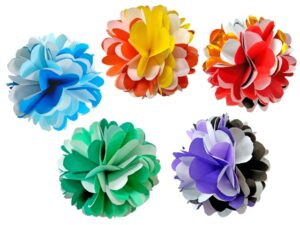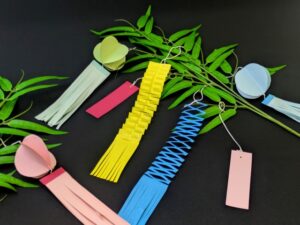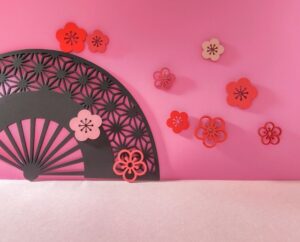During the hot summer season, how do you convey greetings to your loved ones? In an era where email and LINE messaging are commonplace, summer greeting cards sent on handwritten stationery hold special value.
“I want to write summer greeting cards on stationery, but what design should I choose?” “I’m worried about writing proper text for superiors without being rude” “I don’t understand the timing and etiquette well” – many people may have such concerns.
Actually, anyone can write wonderful heartfelt summer greeting cards by mastering appropriate stationery selection and basic writing techniques. We’ll introduce how to create memorable stationery that will make recipients think “I’m so happy to receive such thoughtful greetings” and be moved. Let’s create warm summer greeting cards that resonate with the hearts of modern people tired of digital communication.
What are Summer Greeting Cards on Stationery? Meaning and Characteristics
Summer greeting cards on stationery are a beautiful Japanese culture where you send care for others and seasonal greetings during the hot summer period. Since you can write more content than postcards, you can convey deeper feelings and detailed personal updates. The big attraction is that you can safely write private content since it’s sent in an envelope.
Basic Meaning of Summer Greeting Cards on Stationery
Summer greeting cards on stationery are letters sent during the hot summer period to show care for the recipient’s health and well-being, along with seasonal greetings. This beautiful Japanese culture has continued since the Edo period, expressing the caring sentiment of “Please stay healthy despite the heat.”
Using stationery allows you to write more text than postcards, enabling you to convey more detailed personal updates and heartfelt messages. The big attraction is that you can safely write private content since it’s sent in an envelope.
Differences Between Summer Greeting Cards on Stationery and Postcards
The biggest difference between stationery and postcards is the depth of content you can express. While postcards are suitable for brief greetings, stationery allows you to politely write detailed personal updates, expressions of gratitude, and thanks for mid-year gifts.
Additionally, since stationery is placed in envelopes, you can safely send personal content or confidential business information. This politeness is particularly valued when greeting superiors or business associates. The writer’s personality and thoughtfulness are more easily conveyed, leaving a deeper impression on recipients.
History and Cultural Background of Summer Greeting Cards on Stationery
The history of summer greeting cards dates back to the Edo period. Originally, there was a custom called “summer purification” where people brought gifts to help get through the hot summer. During the Meiji period, with the development of the postal system, letter greetings became common.
After the war, stationery culture particularly flourished, with many beautiful designs and seasonal stationery being created. In modern times, despite digitalization, this culture is carefully preserved by people seeking the warmth of handwriting. Understanding this cultural background allows you to write more heartfelt summer greeting cards.
How to Choose Summer Greeting Card Stationery and Recommended Designs
Stationery selection is an important element that expresses your feelings toward the recipient. Choosing designs with seasonal appeal and quality appropriate for the recipient creates heartfelt summer greeting cards. By selecting high-quality paper and beautiful designs, you can express respect and thoughtfulness toward the recipient.
Key Points for Choosing Summer Greeting Card Stationery
The basics of stationery selection are “consideration for the recipient” and “seasonal appeal.” First, consider the recipient’s position and your relationship with them. For superiors or business associates, choose elegant and modest designs; for close friends and family, choose distinctive and warm designs.
Paper quality is also an important element. Choosing high-quality paper with good texture gives a good impression to recipients.
Also consider how it feels when writing with fountain pens or ballpoint pens. Additionally, choosing set products with envelopes creates a unified and beautiful finish.
Designs that Create Seasonal Appeal
You can create seasonal appeal by choosing cool summer motifs. Stationery with summer illustrations like morning glories, wind chimes, goldfish, fireworks, the sea, and blue skies makes you feel cool just by looking at them.
Color usage is also important, with cool water blue, light green, and white-based designs being popular. Transparent watercolor-style illustrations and Japanese-style designs that utilize the texture of Japanese paper can also express the beauty of Japanese summers. Choosing seasonal limited designs can also create a special feeling.
Choosing Stationery According to the Recipient
For superiors or business associates, choose simple and elegant designs. Those based on white or light cream colors with modest Japanese-style motifs are appropriate. Luxurious designs using gold or silver foil are also appreciated.
For close friends and family, you can choose slightly more casual and distinctive designs without problems. Create intimacy with stationery featuring cute illustrations or vibrant colors. For families with children, pop designs that the whole family can enjoy are also recommended.
Examples of Recommended Summer Greeting Card Stationery Designs
Popular designs include stationery with transparent watercolor-style morning glories and goldfish. These have rich seasonal appeal and are appreciated by people of all ages.
Also, Japanese-style designs featuring cool bamboo blinds (sudare) or bamboo groves give an elegant and sophisticated impression.
For those looking for modern designs, stationery with simple geometric patterns incorporating summer colors is recommended. It’s easy to use for business associates while expressing personality.
For children, stationery with cute penguins, ice cream, and other fun summer motifs is popular.
How to Use Stationery and Envelope Sets
Using stationery and envelopes as a set creates a unified and beautiful finish. Matching the envelope’s color and pattern to the stationery can build anticipation even before opening. Also, choosing set products where the same motifs are drawn on the envelope creates a more sophisticated impression.
Envelope selection is also important – choose ones with appropriate thickness so the stationery doesn’t show through. Types with colors or patterns on the inside of the envelope can also create a surprise feeling when opened. Choosing stamps with seasonal appeal conveys attention to detail and thoughtfulness.
How to Write Summer Greeting Cards on Stationery and Etiquette
To write beautiful summer greeting cards, it’s important to understand proper composition and etiquette. By using appropriate honorific language and expressions according to your relationship with the recipient, you can create more heartfelt stationery. While utilizing the warmth of handwriting, aim for polite writing.
Basic Composition of Summer Greeting Cards on Stationery
The basic composition of summer greeting cards on stationery follows this order: “greeting,” “seasonal greeting,” “personal update,” “care for the recipient,” “closing words,” and “date and signature.” Start with “Summer greetings to you” and continue with seasonal greetings.
Next, briefly report your personal situation, and add words showing care for the recipient’s health and well-being. Finally, conclude with closing words like “The hot days continue, but please take care of your health,” and include the date and signature. Following this composition creates polite and heartfelt stationery.
Etiquette and Precautions When Writing
As basic etiquette when writing on stationery, it’s important to first maintain consistent character size and write carefully. Hastily written characters can give a rude impression to the recipient. Also, avoid using correction fluid or correction tape – if you make a mistake, rewrite on new stationery.
Vertical writing is basic, but horizontal writing is also acceptable. However, vertical writing gives a more polite impression to superiors. Space lines appropriately for readability and pay attention to punctuation usage. Also write addresses on envelopes carefully and use honorifics like “sama” and “dono” correctly.
Consideration for Superiors and Business Associates
For summer greeting cards to superiors or business associates, use more polite honorific language. Aim for dignified expressions like “Despite the hot weather” and “I’m delighted to hear of your continued good health.” Keep personal updates brief and don’t forget to express gratitude to the recipient.
For company associates, it’s appropriate to mention work-related gratitude and future aspirations rather than personal content. Express your feelings about valuing ongoing relationships with words like “Please continue to provide your guidance.”
Points for Casual Recipients
For summer greeting cards to close friends and family, you can use more approachable expressions. Create intimacy with natural language like “The hot days continue – how are you doing?”
Weaving in personal episodes and memories makes the content more heartfelt. Including specific topics like “The fireworks festival the other day was so enjoyable” or “How are your summer vacation plans?” helps recipients feel close to you.
Tips for Conveying Heart Through Handwriting
The greatest charm of handwriting is that the writer’s personality and feelings appear in the characters. By writing carefully and slowly, your thoughtfulness toward the recipient is conveyed. Especially for the recipient’s name and important parts, aim to write more carefully.
Maintaining consistent character size and pen pressure creates a readable and beautiful finish. Using fountain pens or brush pens can give a more elegant impression. Also, adding handwritten pictures or illustrations at the end of the text can create originality.
Sample Texts and Examples for Summer Greeting Cards on Stationery
We’ll introduce sample texts by situation that are helpful when actually writing stationery. By choosing appropriate expressions according to your relationship with the recipient and the purpose of sending, you can write more effective summer greeting cards. The key is adding your own words while maintaining basic composition.
General Summer Greeting Card Stationery Sample Texts
We’ll introduce basic sample text for general summer greeting cards.
“Summer greetings to you. Hot days continue every day, but how are you spending your time? Thanks to you, we are living healthily. The heat will continue, but please take care of your health.”
By adding specific personal updates and seasonal topics to this basic pattern, the content becomes more individual.
Weave in familiar topics like “This summer is particularly hot, and we can’t do without air conditioning” or “The morning glories in the garden are blooming beautifully, giving us a cool feeling.”
Sample Texts for Superiors and Business Use
Sample texts for superiors or business associates use more polite expressions.
“Summer greetings to you. While the severe heat continues day after day, I’m delighted to hear that Mr./Ms. ○○ is in increasingly good health. I sincerely thank you for your special kindness always.”
Continue with:
“Thanks to you, we are also living safely. During this intense heat, please take especially good care of your health. Please continue to provide your guidance in the future.”
Conclude with this.
Express respect and gratitude with such polite expressions.
Sample Texts for Close Friends and Family
Sample texts for close relationships can use slightly more casual and friendly expressions.
“Summer greetings to you. It’s really hot every day! How are you spending your time over there? Here, our whole family is healthy and enjoying summer vacation.”
“Thank you for the wonderful mid-year gift you sent recently. The children were delighted. I’m looking forward to seeing you next time. Please stay healthy despite the heat.”
Including specific episodes like this makes the content more heartfelt.
Sample Texts for Mid-Year Gift Thanks and Personal Updates
We’ll also introduce sample texts for summer greeting cards that double as thanks for mid-year gifts.
“Summer greetings to you. Thank you very much for sending the heartfelt mid-year gift. Our whole family is enjoying it very much.”
“Thanks to you, we are living healthily without summer fatigue. The children are also enjoying summer vacation to the fullest, going to the pool every day. Hot days continue, but please take care of your health, Mr./Ms. ○○.”
Write by combining gratitude and personal updates like this.
Timing and Precautions for Sending Summer Greeting Cards on Stationery
By understanding the appropriate timing for sending summer greeting cards, you can maximize their effectiveness as seasonal greetings. Also, by understanding the distinction from late summer greeting cards and detailed precautions when sending, you can create more polite and heartfelt stationery.
Best Timing for Sending Summer Greeting Cards on Stationery
The best timing for sending summer greeting cards is from the end of the rainy season until Risshū (around August 7th).
Generally, mid-July to early August is considered the most appropriate period. Sending during this time makes them function most effectively as seasonal greetings.
Since the end of the rainy season differs by region, also consider the climate of the area where the recipient lives.
In the Kanto region, mid-July is the guideline, and in the Kansai region, late July. If sent too early or too late, the seasonal timing will be off, making timing important.
Differences from Late Summer Greeting Cards and Switching Time
After Risshū passes, it switches from summer greeting cards to late summer greeting cards.
Late summer greeting cards can be sent from mid-August to early September.
“Summer greetings to you” simply changes to “Late summer greetings to you,” with the basic composition remaining the same.
For late summer greeting cards, use expressions like “Though Risshū has passed, hot days continue.” Making this timing switch correctly conveys feelings that value seasonal awareness. It’s also recommended to choose stationery designs that match the late summer period.
Points to Be Careful About When Sending
As precautions when sending stationery, first write addresses on envelopes carefully. Don’t abbreviate addresses and write them accurately. Also, pay attention to stamp position and direction. The basic rule is to place them vertically on the upper left of the envelope.
Before mailing, always check that there are no errors in the stationery content. Especially carefully check important parts like the recipient’s name, honorifics, and dates. Also confirm that the stationery doesn’t stick out from the envelope and that it’s properly sealed.
Why Summer Greeting Cards on Stationery Are Chosen and Underlying Needs
Because it’s the digital age, the need for handwritten stationery is increasing.
Being able to convey deep feelings and detailed information that can’t be fully expressed on postcards is the great appeal of stationery. It’s attracting attention as a medium that can create the “special feeling” and “individuality” that modern people seek.
Benefits of Sending on Stationery
The greatest benefit of summer greeting cards on stationery is being able to convey deep feelings and detailed personal updates that can’t be fully expressed on postcards.
Since you can use multiple sheets, you can convey various content at once, such as thanks for mid-year gifts, personal updates, and words of gratitude.
Also, placing them in envelopes allows you to safely write private content. For business associates, you can send confidential information, helping deepen trust relationships. The warmth of handwriting conveys humanity that can’t be expressed digitally.
Why Stationery Is Appreciated in the Digital Age
Because digitalization is advancing in modern times, handwritten stationery holds special value.
Now that email and SNS greetings are commonplace, handwritten summer greeting cards make a strong impression on recipients.
Stationery written with time and effort is received as an expression of sincere feelings toward the recipient.
Also, since stationery remains as a physical form, it’s likely to be carefully preserved as a memory. While digital messages tend to be quickly deleted, beautiful stationery is often kept nearby for a long time and read repeatedly.
What’s Required of Summer Greeting Cards on Stationery
What’s required of modern summer greeting cards on stationery are “seasonal appeal,” “individuality,” and “quality” – these three elements.
For seasonal appeal, summer-like designs and cool color schemes are important. For individuality, unique designs and writing that convey the sender’s personality are sought.
For quality, products with attention to detail such as paper texture, printing beauty, and coordination with envelopes are appreciated.
Particularly, environmentally-conscious stationery using recycled paper and luxury stationery using traditional Japanese washi paper are gaining popularity.
Points That Please Recipients with Summer Greeting Cards on Stationery
To write summer greeting cards that deeply resonate with recipients’ hearts, there are several tips. By skillfully creating seasonal appeal and individuality while incorporating feelings of caring for the recipient into your writing, you can create wonderful and memorable stationery.
Crafting Messages That Remain in Recipients’ Hearts
The key to writing messages that remain in recipients’ hearts is weaving in specific episodes and feelings of gratitude.
Rather than just “Thank you for your continued support,” express specific gratitude like “Thanks to your valuable advice on the recent project, we were able to lead it to success.”
Also, touching on the recipient’s hobbies and interests is also effective. Messages that show you remember things about the recipient, such as “You enjoy gardening – what kinds of flowers are you growing this summer?” leave a deep impression.
Ideas for Creating Seasonal Appeal and Individuality
To create seasonal appeal, incorporate summer-like expressions into your writing, not just the stationery design.
Using seasonal expressions like “cicadas singing,” “the cool sound of wind chimes,” or “evening coolness is pleasant” allows readers to envision summer scenes.
To create individuality, it’s important to add words that are uniquely yours.
“This year I’m challenging myself to grow tomatoes in my home garden”
“I joined a new book club and rediscovered the joy of reading”
Writing about your personal situation concretely like this conveys your personality.
Characteristics of Pleasant Summer Greeting Cards on Stationery
The characteristics of summer greeting cards on stationery that are pleasant to receive are “heartfelt handwritten characters,” “beautiful designs with seasonal appeal,” and “content that shows consideration for the recipient” – these three elements. Stationery that combines these deeply resonates with recipients’ hearts.
Particularly, words that show care for the recipient’s situation and content that reflects on past memories make strong impressions.
Aim for writing that conveys feelings of caring for the recipient, such as “Even though you’re busy, please take care of your health” or “The fireworks festival we went to together last year brings back fond memories.”
Summary
The key points are summarized as follows:
- Realize heartfelt greetings through seasonal design selection and stationery suited to the recipient
- Following basic composition and etiquette, creating writing that utilizes the warmth of handwriting is important
- Sending at the appropriate time from mid-July to early August makes for effective seasonal greetings
- Create messages that remain in recipients’ hearts by incorporating specific episodes and feelings of gratitude
Summer greeting cards on stationery are a heartfelt greeting method that has value precisely because it’s the digital age. Why not start this wonderful summer custom that deepens bonds with important people through appropriate stationery selection and careful writing?














Comments